Consumer Behaviour and Insight: Decision-Making Process at Waitrose
VerifiedAdded on 2020/12/28
|7
|1536
|431
Report
AI Summary
This report provides an analysis of consumer behavior and decision-making processes, focusing on Waitrose & Partners, a UK-based food retailer. It explores various models of consumer decision-making, including economic, passive, cognitive, and emotional models, and maps out the decision-making process for organic food products, from need recognition to post-purchase evaluation. The report highlights the importance of understanding consumer behavior for businesses to improve sales, brand image, and customer satisfaction. It also discusses different levels of consumer decision-making, such as extensive problem solving, limited problem solving, and routinized response behavior, along with personal, purchasing power, and cultural factors that influence these decisions. The conclusion emphasizes the need for firms to align their offerings with customer needs to ensure satisfaction and sustain market competitiveness.
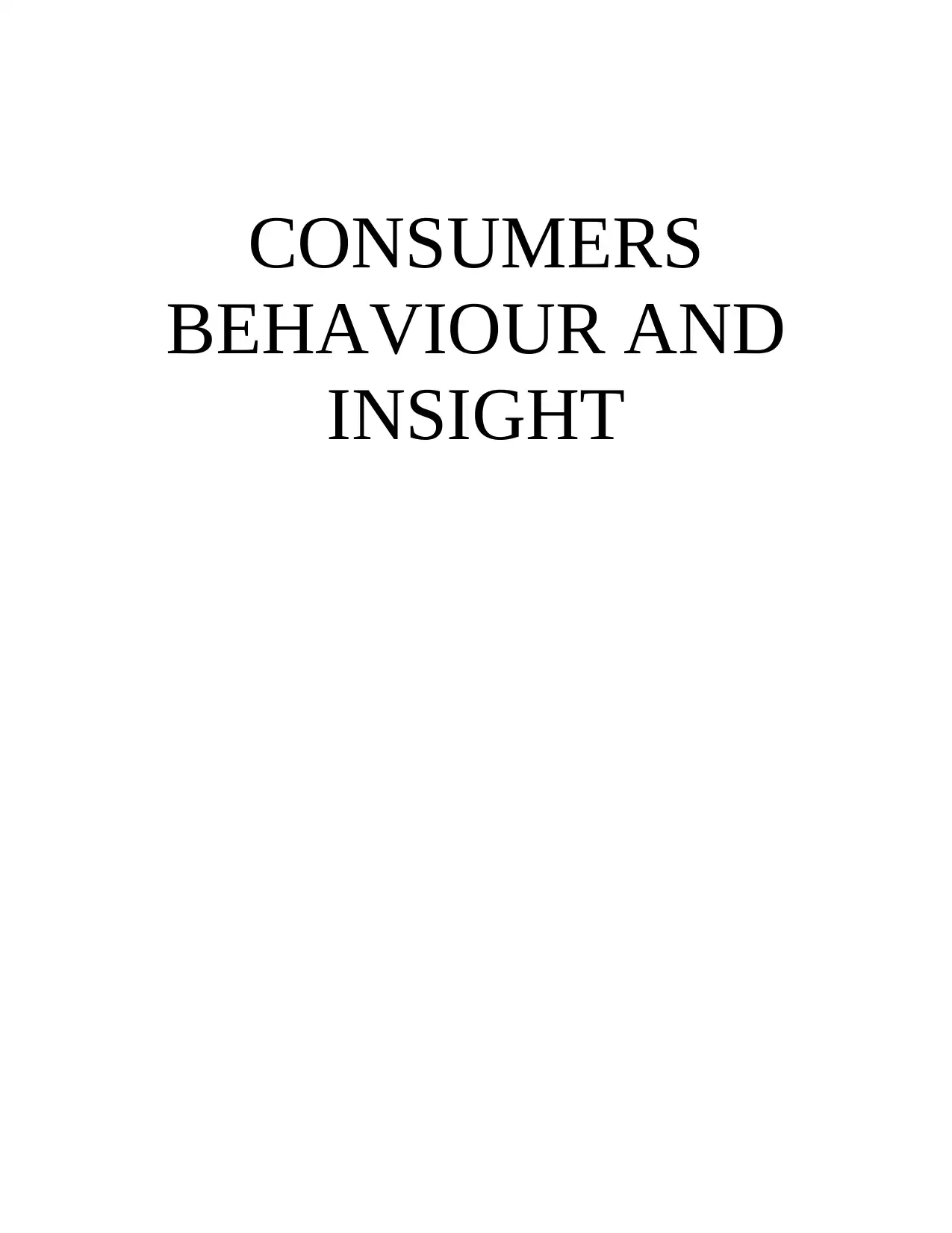
CONSUMERS
BEHAVIOUR AND
INSIGHT
BEHAVIOUR AND
INSIGHT
Paraphrase This Document
Need a fresh take? Get an instant paraphrase of this document with our AI Paraphraser
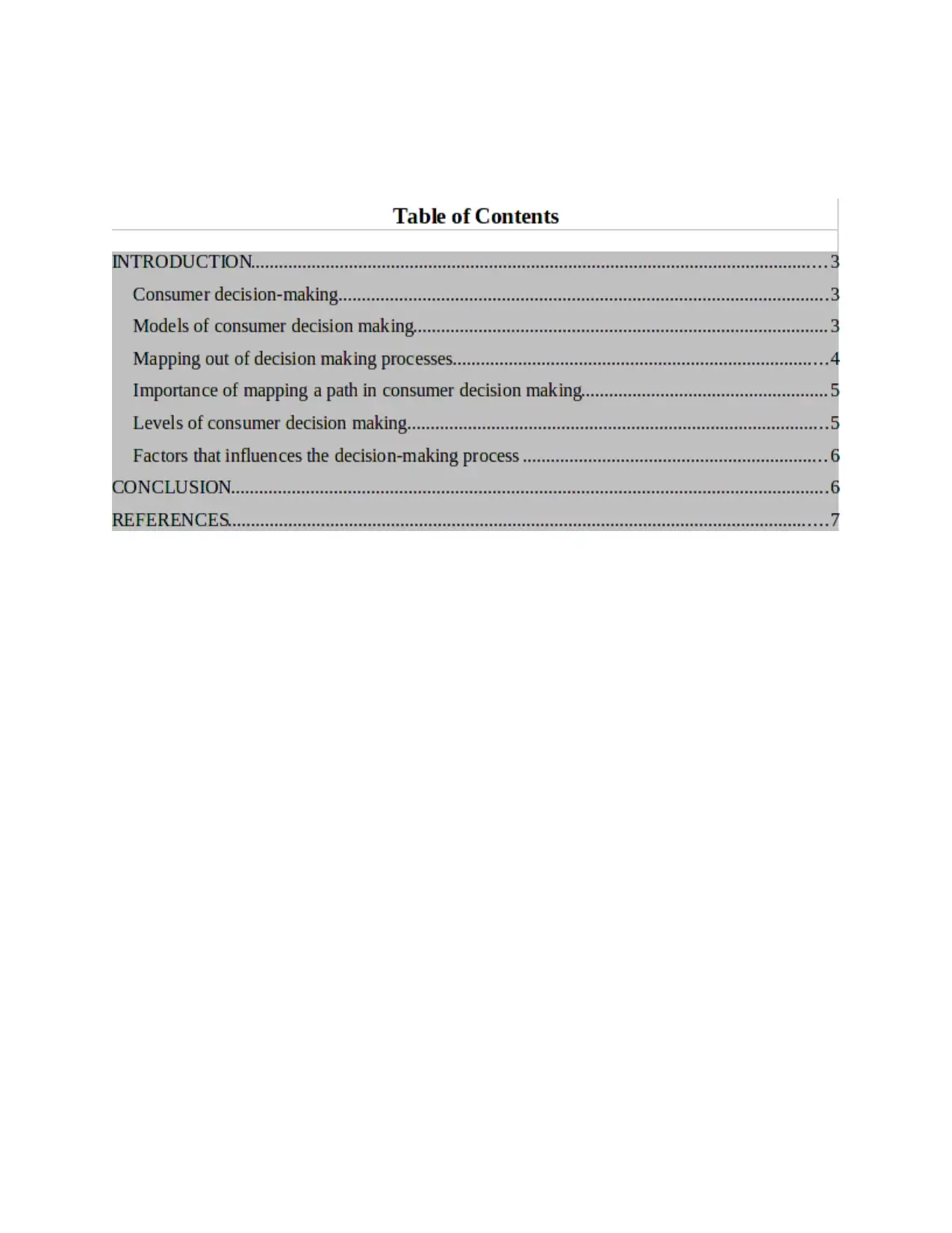
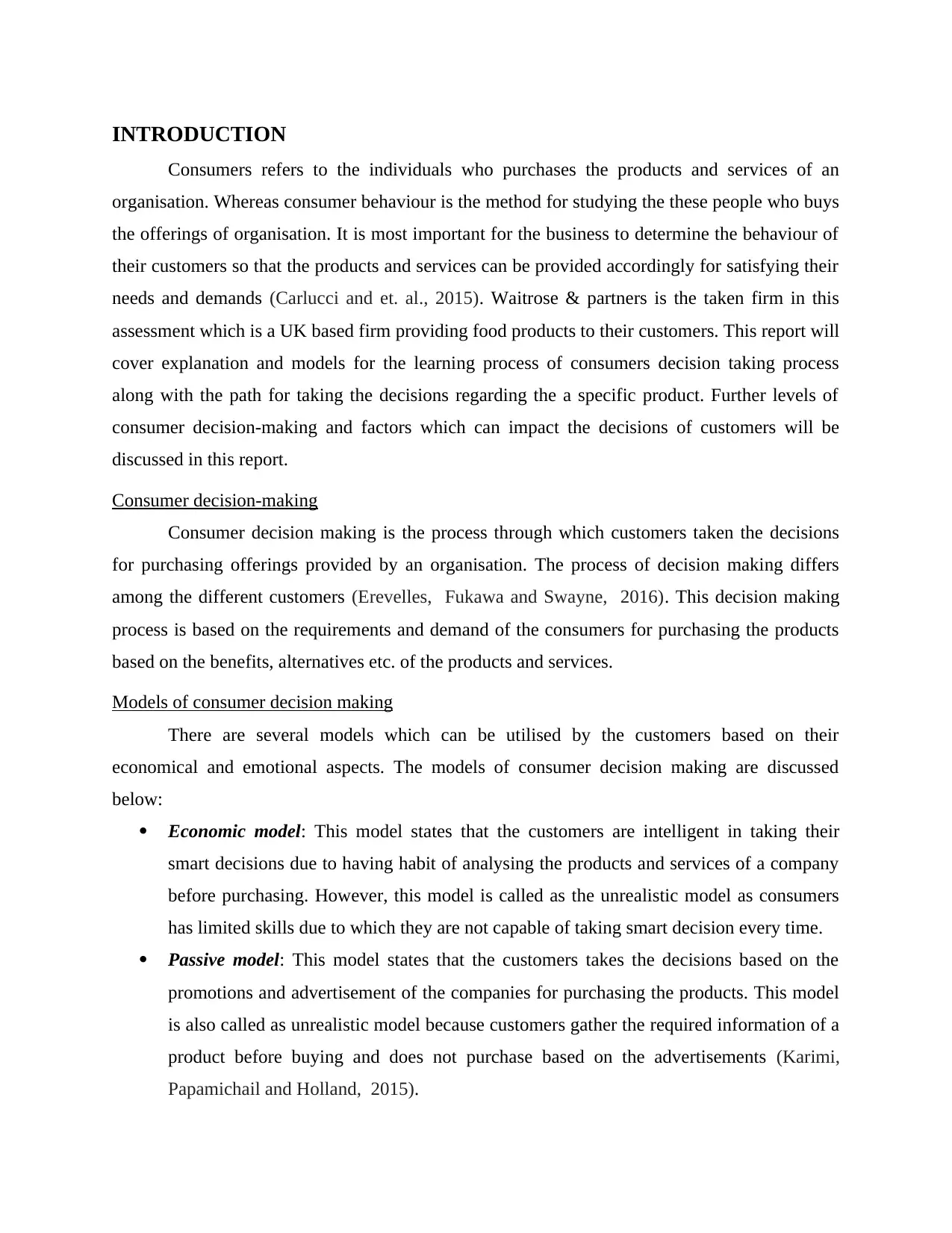
INTRODUCTION
Consumers refers to the individuals who purchases the products and services of an
organisation. Whereas consumer behaviour is the method for studying the these people who buys
the offerings of organisation. It is most important for the business to determine the behaviour of
their customers so that the products and services can be provided accordingly for satisfying their
needs and demands (Carlucci and et. al., 2015). Waitrose & partners is the taken firm in this
assessment which is a UK based firm providing food products to their customers. This report will
cover explanation and models for the learning process of consumers decision taking process
along with the path for taking the decisions regarding the a specific product. Further levels of
consumer decision-making and factors which can impact the decisions of customers will be
discussed in this report.
Consumer decision-making
Consumer decision making is the process through which customers taken the decisions
for purchasing offerings provided by an organisation. The process of decision making differs
among the different customers (Erevelles, Fukawa and Swayne, 2016). This decision making
process is based on the requirements and demand of the consumers for purchasing the products
based on the benefits, alternatives etc. of the products and services.
Models of consumer decision making
There are several models which can be utilised by the customers based on their
economical and emotional aspects. The models of consumer decision making are discussed
below:
Economic model: This model states that the customers are intelligent in taking their
smart decisions due to having habit of analysing the products and services of a company
before purchasing. However, this model is called as the unrealistic model as consumers
has limited skills due to which they are not capable of taking smart decision every time.
Passive model: This model states that the customers takes the decisions based on the
promotions and advertisement of the companies for purchasing the products. This model
is also called as unrealistic model because customers gather the required information of a
product before buying and does not purchase based on the advertisements (Karimi,
Papamichail and Holland, 2015).
Consumers refers to the individuals who purchases the products and services of an
organisation. Whereas consumer behaviour is the method for studying the these people who buys
the offerings of organisation. It is most important for the business to determine the behaviour of
their customers so that the products and services can be provided accordingly for satisfying their
needs and demands (Carlucci and et. al., 2015). Waitrose & partners is the taken firm in this
assessment which is a UK based firm providing food products to their customers. This report will
cover explanation and models for the learning process of consumers decision taking process
along with the path for taking the decisions regarding the a specific product. Further levels of
consumer decision-making and factors which can impact the decisions of customers will be
discussed in this report.
Consumer decision-making
Consumer decision making is the process through which customers taken the decisions
for purchasing offerings provided by an organisation. The process of decision making differs
among the different customers (Erevelles, Fukawa and Swayne, 2016). This decision making
process is based on the requirements and demand of the consumers for purchasing the products
based on the benefits, alternatives etc. of the products and services.
Models of consumer decision making
There are several models which can be utilised by the customers based on their
economical and emotional aspects. The models of consumer decision making are discussed
below:
Economic model: This model states that the customers are intelligent in taking their
smart decisions due to having habit of analysing the products and services of a company
before purchasing. However, this model is called as the unrealistic model as consumers
has limited skills due to which they are not capable of taking smart decision every time.
Passive model: This model states that the customers takes the decisions based on the
promotions and advertisement of the companies for purchasing the products. This model
is also called as unrealistic model because customers gather the required information of a
product before buying and does not purchase based on the advertisements (Karimi,
Papamichail and Holland, 2015).
⊘ This is a preview!⊘
Do you want full access?
Subscribe today to unlock all pages.

Trusted by 1+ million students worldwide
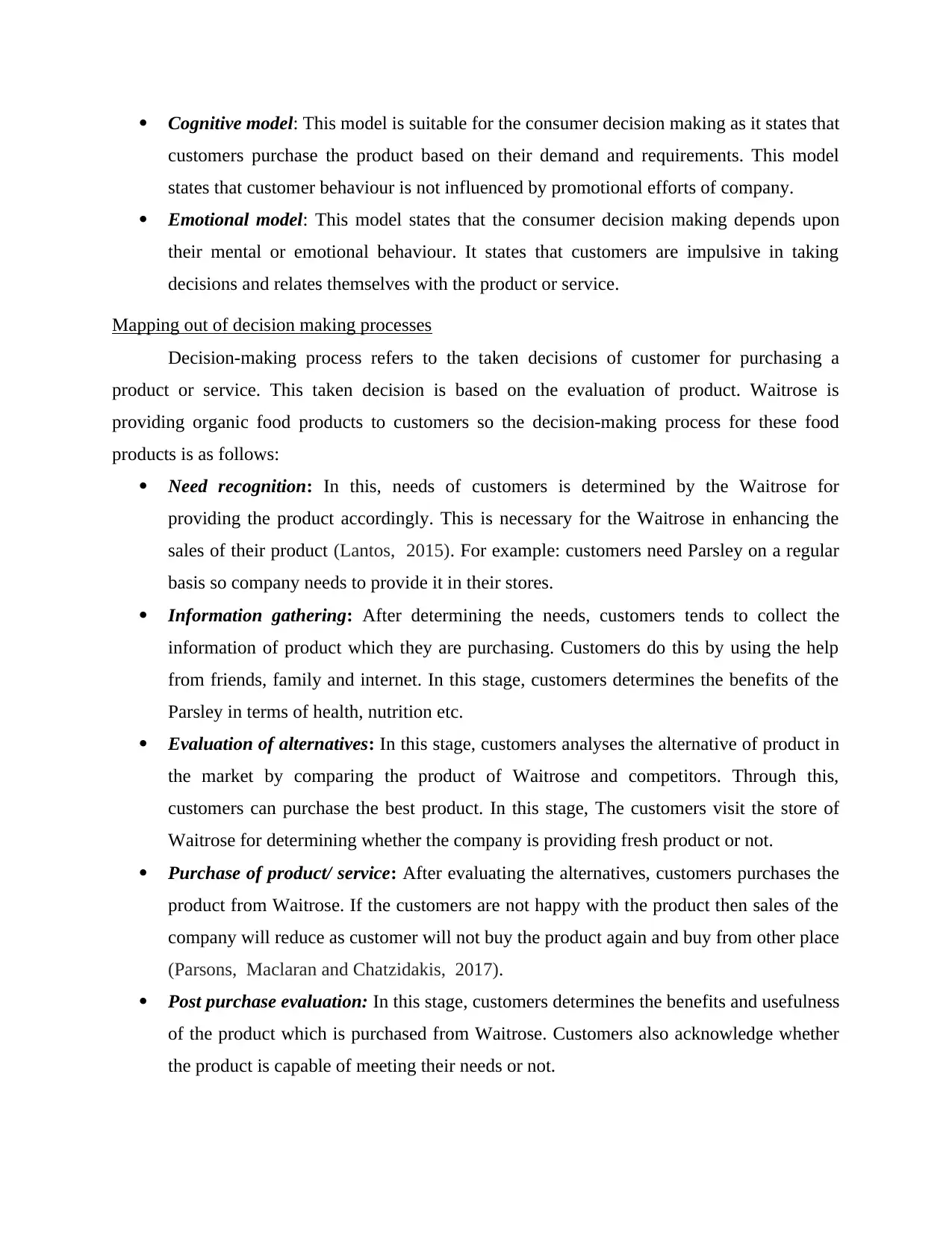
Cognitive model: This model is suitable for the consumer decision making as it states that
customers purchase the product based on their demand and requirements. This model
states that customer behaviour is not influenced by promotional efforts of company.
Emotional model: This model states that the consumer decision making depends upon
their mental or emotional behaviour. It states that customers are impulsive in taking
decisions and relates themselves with the product or service.
Mapping out of decision making processes
Decision-making process refers to the taken decisions of customer for purchasing a
product or service. This taken decision is based on the evaluation of product. Waitrose is
providing organic food products to customers so the decision-making process for these food
products is as follows:
Need recognition: In this, needs of customers is determined by the Waitrose for
providing the product accordingly. This is necessary for the Waitrose in enhancing the
sales of their product (Lantos, 2015). For example: customers need Parsley on a regular
basis so company needs to provide it in their stores.
Information gathering: After determining the needs, customers tends to collect the
information of product which they are purchasing. Customers do this by using the help
from friends, family and internet. In this stage, customers determines the benefits of the
Parsley in terms of health, nutrition etc.
Evaluation of alternatives: In this stage, customers analyses the alternative of product in
the market by comparing the product of Waitrose and competitors. Through this,
customers can purchase the best product. In this stage, The customers visit the store of
Waitrose for determining whether the company is providing fresh product or not.
Purchase of product/ service: After evaluating the alternatives, customers purchases the
product from Waitrose. If the customers are not happy with the product then sales of the
company will reduce as customer will not buy the product again and buy from other place
(Parsons, Maclaran and Chatzidakis, 2017).
Post purchase evaluation: In this stage, customers determines the benefits and usefulness
of the product which is purchased from Waitrose. Customers also acknowledge whether
the product is capable of meeting their needs or not.
customers purchase the product based on their demand and requirements. This model
states that customer behaviour is not influenced by promotional efforts of company.
Emotional model: This model states that the consumer decision making depends upon
their mental or emotional behaviour. It states that customers are impulsive in taking
decisions and relates themselves with the product or service.
Mapping out of decision making processes
Decision-making process refers to the taken decisions of customer for purchasing a
product or service. This taken decision is based on the evaluation of product. Waitrose is
providing organic food products to customers so the decision-making process for these food
products is as follows:
Need recognition: In this, needs of customers is determined by the Waitrose for
providing the product accordingly. This is necessary for the Waitrose in enhancing the
sales of their product (Lantos, 2015). For example: customers need Parsley on a regular
basis so company needs to provide it in their stores.
Information gathering: After determining the needs, customers tends to collect the
information of product which they are purchasing. Customers do this by using the help
from friends, family and internet. In this stage, customers determines the benefits of the
Parsley in terms of health, nutrition etc.
Evaluation of alternatives: In this stage, customers analyses the alternative of product in
the market by comparing the product of Waitrose and competitors. Through this,
customers can purchase the best product. In this stage, The customers visit the store of
Waitrose for determining whether the company is providing fresh product or not.
Purchase of product/ service: After evaluating the alternatives, customers purchases the
product from Waitrose. If the customers are not happy with the product then sales of the
company will reduce as customer will not buy the product again and buy from other place
(Parsons, Maclaran and Chatzidakis, 2017).
Post purchase evaluation: In this stage, customers determines the benefits and usefulness
of the product which is purchased from Waitrose. Customers also acknowledge whether
the product is capable of meeting their needs or not.
Paraphrase This Document
Need a fresh take? Get an instant paraphrase of this document with our AI Paraphraser
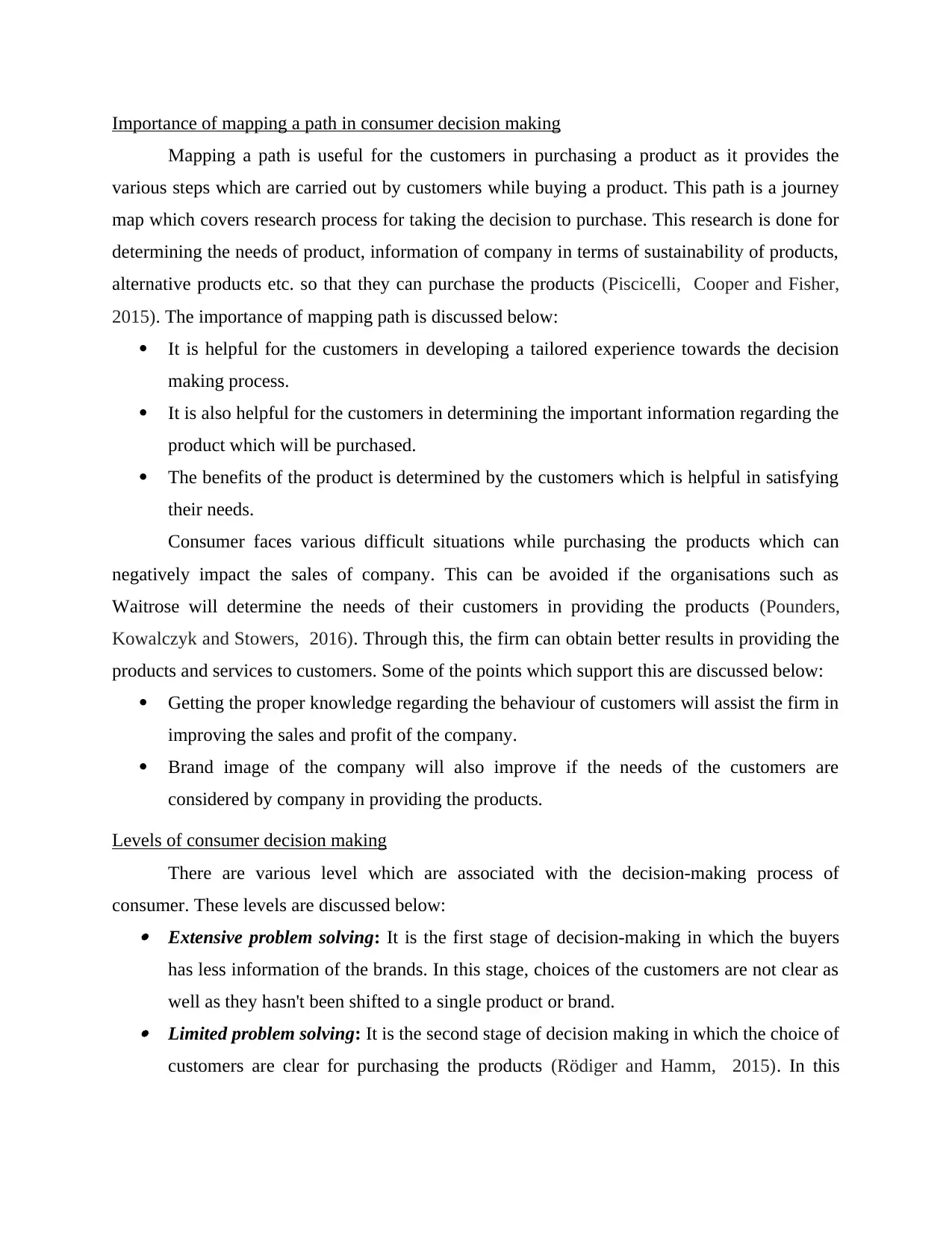
Importance of mapping a path in consumer decision making
Mapping a path is useful for the customers in purchasing a product as it provides the
various steps which are carried out by customers while buying a product. This path is a journey
map which covers research process for taking the decision to purchase. This research is done for
determining the needs of product, information of company in terms of sustainability of products,
alternative products etc. so that they can purchase the products (Piscicelli, Cooper and Fisher,
2015). The importance of mapping path is discussed below:
It is helpful for the customers in developing a tailored experience towards the decision
making process.
It is also helpful for the customers in determining the important information regarding the
product which will be purchased.
The benefits of the product is determined by the customers which is helpful in satisfying
their needs.
Consumer faces various difficult situations while purchasing the products which can
negatively impact the sales of company. This can be avoided if the organisations such as
Waitrose will determine the needs of their customers in providing the products (Pounders,
Kowalczyk and Stowers, 2016). Through this, the firm can obtain better results in providing the
products and services to customers. Some of the points which support this are discussed below:
Getting the proper knowledge regarding the behaviour of customers will assist the firm in
improving the sales and profit of the company.
Brand image of the company will also improve if the needs of the customers are
considered by company in providing the products.
Levels of consumer decision making
There are various level which are associated with the decision-making process of
consumer. These levels are discussed below: Extensive problem solving: It is the first stage of decision-making in which the buyers
has less information of the brands. In this stage, choices of the customers are not clear as
well as they hasn't been shifted to a single product or brand. Limited problem solving: It is the second stage of decision making in which the choice of
customers are clear for purchasing the products (Rödiger and Hamm, 2015). In this
Mapping a path is useful for the customers in purchasing a product as it provides the
various steps which are carried out by customers while buying a product. This path is a journey
map which covers research process for taking the decision to purchase. This research is done for
determining the needs of product, information of company in terms of sustainability of products,
alternative products etc. so that they can purchase the products (Piscicelli, Cooper and Fisher,
2015). The importance of mapping path is discussed below:
It is helpful for the customers in developing a tailored experience towards the decision
making process.
It is also helpful for the customers in determining the important information regarding the
product which will be purchased.
The benefits of the product is determined by the customers which is helpful in satisfying
their needs.
Consumer faces various difficult situations while purchasing the products which can
negatively impact the sales of company. This can be avoided if the organisations such as
Waitrose will determine the needs of their customers in providing the products (Pounders,
Kowalczyk and Stowers, 2016). Through this, the firm can obtain better results in providing the
products and services to customers. Some of the points which support this are discussed below:
Getting the proper knowledge regarding the behaviour of customers will assist the firm in
improving the sales and profit of the company.
Brand image of the company will also improve if the needs of the customers are
considered by company in providing the products.
Levels of consumer decision making
There are various level which are associated with the decision-making process of
consumer. These levels are discussed below: Extensive problem solving: It is the first stage of decision-making in which the buyers
has less information of the brands. In this stage, choices of the customers are not clear as
well as they hasn't been shifted to a single product or brand. Limited problem solving: It is the second stage of decision making in which the choice of
customers are clear for purchasing the products (Rödiger and Hamm, 2015). In this
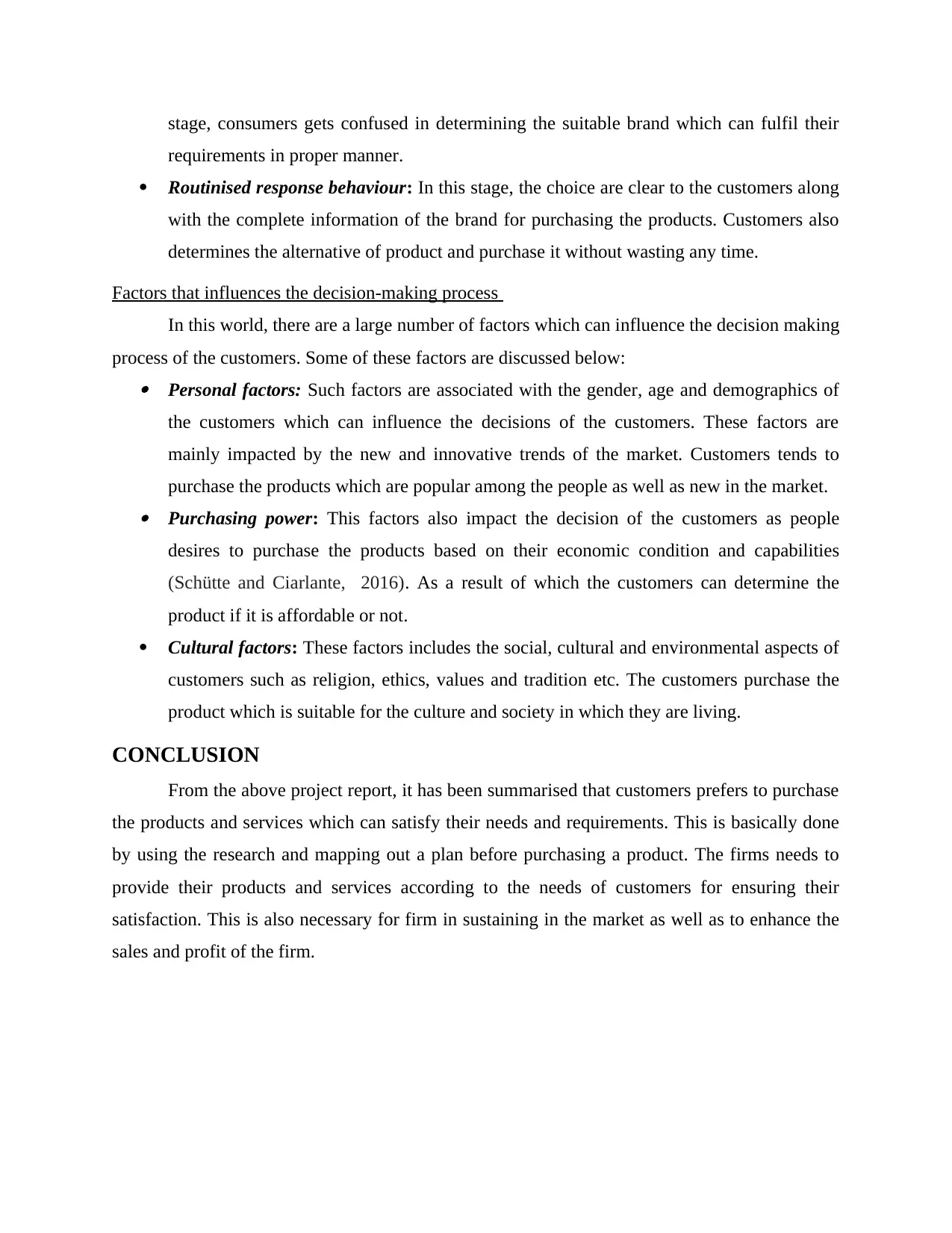
stage, consumers gets confused in determining the suitable brand which can fulfil their
requirements in proper manner.
Routinised response behaviour: In this stage, the choice are clear to the customers along
with the complete information of the brand for purchasing the products. Customers also
determines the alternative of product and purchase it without wasting any time.
Factors that influences the decision-making process
In this world, there are a large number of factors which can influence the decision making
process of the customers. Some of these factors are discussed below: Personal factors: Such factors are associated with the gender, age and demographics of
the customers which can influence the decisions of the customers. These factors are
mainly impacted by the new and innovative trends of the market. Customers tends to
purchase the products which are popular among the people as well as new in the market. Purchasing power: This factors also impact the decision of the customers as people
desires to purchase the products based on their economic condition and capabilities
(Schütte and Ciarlante, 2016). As a result of which the customers can determine the
product if it is affordable or not.
Cultural factors: These factors includes the social, cultural and environmental aspects of
customers such as religion, ethics, values and tradition etc. The customers purchase the
product which is suitable for the culture and society in which they are living.
CONCLUSION
From the above project report, it has been summarised that customers prefers to purchase
the products and services which can satisfy their needs and requirements. This is basically done
by using the research and mapping out a plan before purchasing a product. The firms needs to
provide their products and services according to the needs of customers for ensuring their
satisfaction. This is also necessary for firm in sustaining in the market as well as to enhance the
sales and profit of the firm.
requirements in proper manner.
Routinised response behaviour: In this stage, the choice are clear to the customers along
with the complete information of the brand for purchasing the products. Customers also
determines the alternative of product and purchase it without wasting any time.
Factors that influences the decision-making process
In this world, there are a large number of factors which can influence the decision making
process of the customers. Some of these factors are discussed below: Personal factors: Such factors are associated with the gender, age and demographics of
the customers which can influence the decisions of the customers. These factors are
mainly impacted by the new and innovative trends of the market. Customers tends to
purchase the products which are popular among the people as well as new in the market. Purchasing power: This factors also impact the decision of the customers as people
desires to purchase the products based on their economic condition and capabilities
(Schütte and Ciarlante, 2016). As a result of which the customers can determine the
product if it is affordable or not.
Cultural factors: These factors includes the social, cultural and environmental aspects of
customers such as religion, ethics, values and tradition etc. The customers purchase the
product which is suitable for the culture and society in which they are living.
CONCLUSION
From the above project report, it has been summarised that customers prefers to purchase
the products and services which can satisfy their needs and requirements. This is basically done
by using the research and mapping out a plan before purchasing a product. The firms needs to
provide their products and services according to the needs of customers for ensuring their
satisfaction. This is also necessary for firm in sustaining in the market as well as to enhance the
sales and profit of the firm.
⊘ This is a preview!⊘
Do you want full access?
Subscribe today to unlock all pages.

Trusted by 1+ million students worldwide
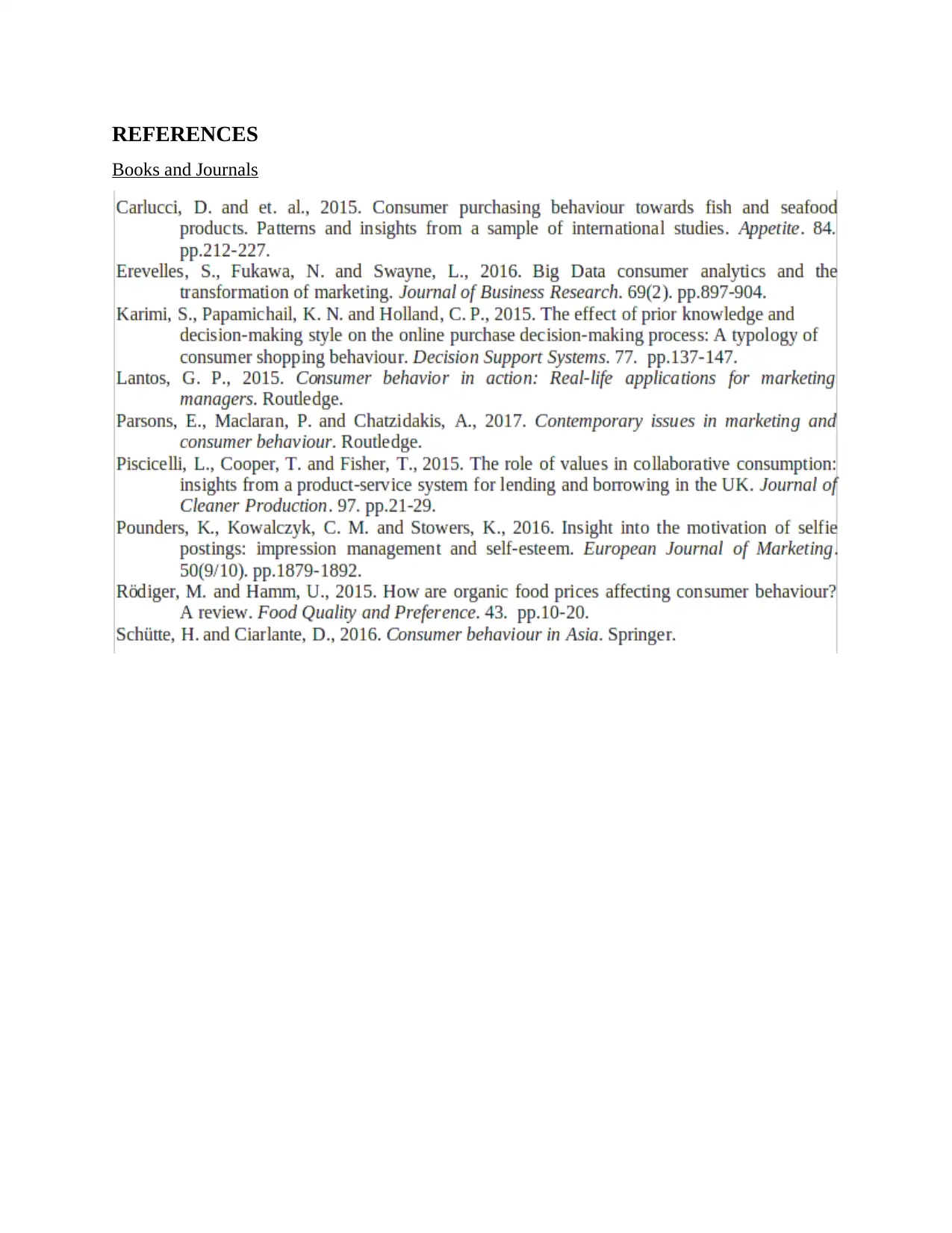
REFERENCES
Books and Journals
Books and Journals
1 out of 7
Related Documents
Your All-in-One AI-Powered Toolkit for Academic Success.
+13062052269
info@desklib.com
Available 24*7 on WhatsApp / Email
![[object Object]](/_next/static/media/star-bottom.7253800d.svg)
Unlock your academic potential
Copyright © 2020–2025 A2Z Services. All Rights Reserved. Developed and managed by ZUCOL.





